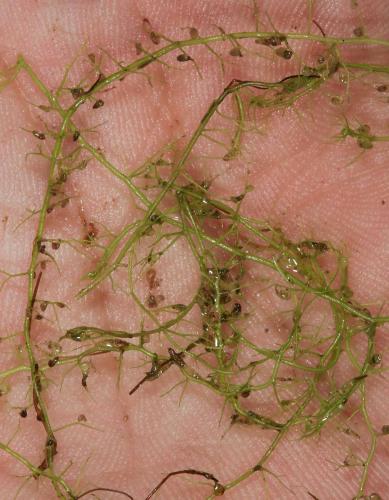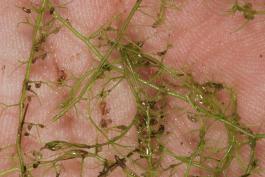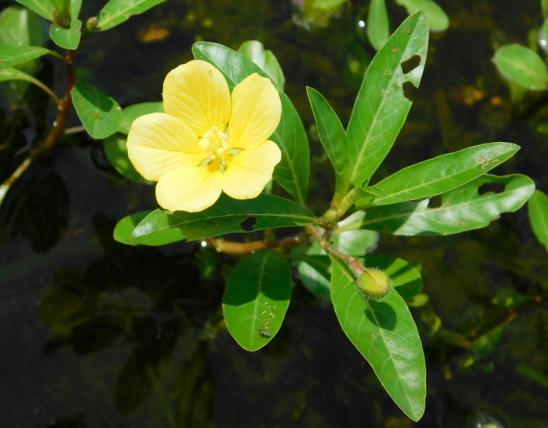
Bladderworts are Missouri’s only carnivorous plants. They are branching, rootless, aquatic plants that tend to grow as a tangled masses under the water surface. The leaves are threadlike. The flowers resemble tiny yellow snapdragons and are held above the water on slender stalks.
Bladderworts get a lot of media attention because they are carnivorous, but don’t get too excited. The baglike bladders that constitute the trap are only about the size of a pinhead, so the animals they trap are quite small: minute aquatic organisms such as tiny crustaceans, minute aquatic insects, mosquito larvae, and newly hatched tadpoles and fish fry.
The trapping mechanism is pretty interesting, however. The traps are globe- or pear-shaped, often are dark red to black, and typically occur at regular intervals along the narrow leaves. Each trap has a small trap door surrounded by hairs that act as triggers. The door is kept shut, resting against a ridge of tissue called a threshold. A thin membrane along the trap door creates a watertight seal. The inner wall of the trap is lined with glands that extract water from the bladder, creating a partial vacuum, bending the walls of the bladder inward.
The trap door secretes a sugary material that may act as bait, and the door is surrounded by trigger hairs, which function as simple levers. When a tiny animal grazes near the hairs, its movements cause the hairs to move, making a small opening in the door seal, which immediately destroys the vacuum, swooshing the door open the rest of the way due to the suction. Within 1/460 of a second, the nearby water, with the animal, are sucked into the trap. The door resumes its closed position with the prey trapped inside. There, the animal eventually exhausts its oxygen or else dies of starvation. The plant digests its prey and absorbs the nutrients.
Four species of bladderworts have been recorded from Missouri. Two have scattered distributions mostly south of the Missouri River, and the other two are rather rare:
- Common bladderwort (or greater bladderwort, U. macrorhiza, formerly U. vulgaris) is one of our more commonly encountered species. Its flowers arise in groups of 6–20. It has the largest flowers of our bladderworts. The petals, including the spur, are ½–¾ inch long. The upper lip is often slightly smaller than the lower lip. The flowers are yellow; the hump-shaped protrusion of the lower lip often is spotted or mottled with red. The lower lip may be unlobed or slightly 3-lobed. The spur is shorter than the lower lip and is usually sharply pointed. The leaves are feather-compound and divided in half to form numerous segments. These feather-compound leaves look more orderly than the foliage of U. gibba. Blooms May–September.
- Humped bladderwort (or swollen-spurred or cone-spur bladderwort, U. gibba) is one of our more commonly encountered species. Its flowers arise in groups of 1–3. Its flowers are about half the size of common bladderwort’s. The petals, including the spur, are ¼–½ inch long. The upper lip is often slightly larger than the lower lip. The yellow flowers sometimes have reddish-brown veins. The lower lip may be unlobed or slightly 2-lobed. The spur may be shorter than or longer than the lower lip and is bluntly pointed at the tip. The leaves are usually deeply divided down the middle once or twice, creating 2 or 4 linear segments. Its floating masses look quite tangled. Scattered mostly south of the Missouri River, mostly in the Ozarks. Blooms May–September.
- Slender bladderwort (or zigzag bladderwort, U. subulata), in Missouri, is known only from Morgan, Reynolds, and Shannon counties, where it grows in open areas of fens with soft, loamy, calcium- and carbon-rich soil (marl). It is unique among our bladderworts because it is more often encountered growing on land, even though the land is water-saturated. The stems mostly creep underground, with only the flowers, and portions of the leaves, rising above the ground. It wasn’t discovered in Missouri until 1995. In May, June, and possibly also September, you may witness the pretty flowers, rising on slender, reddish stalks about 4 inches high, dotting the ground with yellow, but at any other time, the plant will be invisible. Listed as critically imperiled in Missouri.
- Lesser bladderwort (U. minor) was first discovered in Missouri in 2010. It was found in a Shannon County fen. It is a delicate species with flattened leaves (which you’d need magnification to see). It grows in mats as a submerged aquatic, and it holds its flowers above water for only a very short time in spring. Listed as critically imperiled in Missouri.
Similar species: There are many other floating submerged aquatic plants with narrow leaves and/or yellow flowers. Close attention to the description above will help distinguish among these plants.
Length: stems usually 10–40 inches (common bladderwort); less than 8 inches (humped bladderwort).
Potentially statewide. Our two most common species are scattered and sporadic, mostly south of the Missouri River, especially in the Ozarks, in appropriate habitats.
Habitat and Conservation
Missouri’s two widespread species of bladderworts are submerged aquatics (with flowers that rise above the water surface) that occur in ponds, sinkhole ponds, lakes, sloughs, slow-moving portions of streams, and ditches; they may sometimes be stranded on muddy shores.
The general rule for carnivorous plants is that they are native to places where the soils lack nutrients, especially nitrogen. The additional nutrients provided by decaying insect tissues, algae, or other organic materials captured by the plant help them survive in nutrient-poor environments. They commonly grow in wet or acidic, boggy places where dissolved minerals are washed from the soil by nearby streams or in other habitats where nutrients are unavailable.
Status
Two of our four bladderworts are listed as Missouri species of conservation concern: slender bladderwort (U. subulata) and lesser bladderwort (U. minor). Due to their small populations and restricted habitat and range, they are considered critically imperiled.
The common bladderwort (U. macrorhiza) was traditionally considered a subspecies of U. vulgaris, but researchers determined that it should be considered a separate species. U. vulgaris still exists, but only in Europe and Asia.
Human Connections
When you lift a bladderwort plant out of the water, listen carefully: it will make a fine crackling sound as the many tiny traps are sprung. It usually takes about 20 minutes for a trap to reset itself, if nothing was captured.
Some people cultivate bladderworts in aquariums or in aquatic gardens. Note, however, that bladderworts can grow so vigorously in ponds that they can become a nuisance, especially if the pond is used for recreation. In smaller aquatic gardens, however, bladderwort can be kept in check by the presence of other species or by careful tending. The bright yellow blossoms and interesting carnivorous habit may be worth the extra effort.
Obviously, if you are wanting to spawn fish in an aquarium, bladderworts are not recommended, as newly hatched fry, or the tiny live foods you feed to the fry, may be eaten by the plant.
Some people have suggested that bladderworts might be used as a biological control of mosquitoes, since they can consume mosquito larvae.
People are intrigued, or even appalled, by the idea of plants eating animals. It’s certainly inspired plenty of B-grade horror and sci-fi movies. But it’s not a crazy concept: animals, when they die, feed plants with the nutrients of their bodies. It’s part of the nutrient cycle. Why shouldn’t a few plants find ways to speed up the process?
Botanists, including amateur botanists, get a genuine thrill when they discover a plant growing in a place where it had never been known to occur. Imagine how much fun it was to discover the first lesser bladderwort ever found in Missouri: a new record! And imagine how lucky the botanists felt when they realized they happened to be in the right place, at the right time, to see the slender bladderwort in bloom — and to know what they were seeing!
Ecosystem Connections
Several types of bladderworts capture not only tiny animals but also tiny plant particles such as algae and pollen grains. In some species, algae might even make up a majority of the “catch.” It turns out that plant material contributes to the nutrition of many bladderworts. Apparently, the traps may open randomly and capture a variety of organic materials in the nearby water, much of which can be digested. Some researchers have suggested that bladderworts may also benefit when algae grows on their stalks, since that means the nearby algae can easily be drawn into the traps for digestion. Some people might call this farming.
Tiny animal prey, such as daphnia, may be completely sucked into bladderwort traps, but researchers determined that larger prey, which cannot fit entirely inside the traps, can still be eaten. Brace yourself: Small tadpoles and mosquito larvae, for example, may get just their tails stuck in the trap. The digestive juices inside the bladder can digest the tip of the tail, then, by a series of sucks, the trap can draw in the rest of the animal, digesting it in successive stages, finishing with the head.
Bladderworts are members of a plant family that has two other genera, and all three are carnivorous in some way. While the bladderworts (Utricularia) have sacs that entrap aquatic organisms, the butterworts (Pinguicula) catch insects with sticky hairs on their leaf surfaces, and the corkscrew plants (Genlisea) catch insects in specialized pitchers. None of the butterworts or corkscrew plants occur in Missouri.






























































